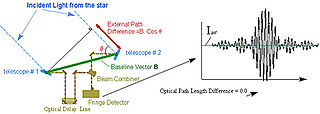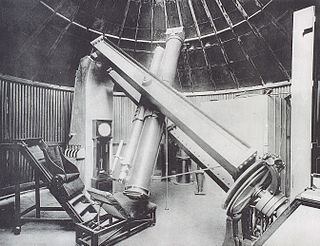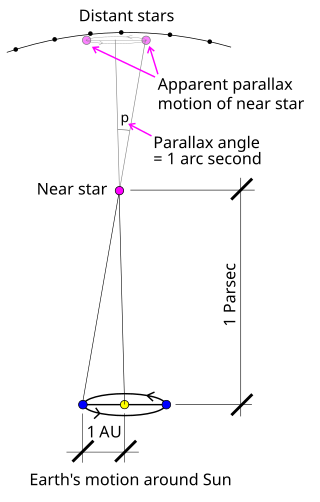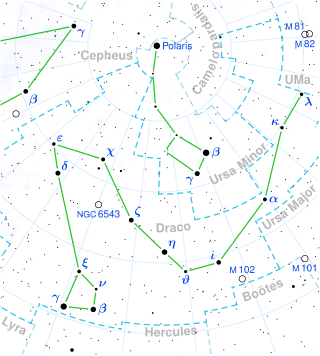Related Research Articles

Astrometry is a branch of astronomy that involves precise measurements of the positions and movements of stars and other celestial bodies. It provides the kinematics and physical origin of the Solar System and this galaxy, the Milky Way.

A star catalogue is an astronomical catalogue that lists stars. In astronomy, many stars are referred to simply by catalogue numbers. There are a great many different star catalogues which have been produced for different purposes over the years, and this article covers only some of the more frequently quoted ones. Star catalogues were compiled by many different ancient people, including the Babylonians, Greeks, Chinese, Persians, and Arabs. They were sometimes accompanied by a star chart for illustration. Most modern catalogues are available in electronic format and can be freely downloaded from space agencies' data centres. The largest is being compiled from the spacecraft Gaia and thus far has over a billion stars.

Proper motion is the astrometric measure of the observed changes in the apparent places of stars or other celestial objects in the sky, as seen from the center of mass of the Solar System, compared to the abstract background of the more distant stars.

The Orion Nebula is a diffuse nebula situated in the Milky Way, being south of Orion's Belt in the constellation of Orion, and is known as the middle "star" in the "sword" of Orion. It is one of the brightest nebulae and is visible to the naked eye in the night sky with apparent magnitude 4.0. It is 1,344 ± 20 light-years (412.1 ± 6.1 pc) away and is the closest region of massive star formation to Earth. The M42 nebula is estimated to be 24 light-years across. It has a mass of about 2,000 times that of the Sun. Older texts frequently refer to the Orion Nebula as the Great Nebula in Orion or the Great Orion Nebula.

The Carte du Ciel and the Astrographic Catalogue were two distinct but connected components of a massive international astronomical project, initiated in the late 19th century, to catalogue and map the positions of millions of stars as faint as 11th or 12th magnitude. Twenty observatories from around the world participated in exposing and measuring more than 22,000 (glass) photographic plates in an enormous observing programme extending over several decades. Despite, or because of, its vast scale, the project was only ever partially successful – the Carte du Ciel component was never completed, and for almost half a century the Astrographic Catalogue part was largely ignored. However, the appearance of the Hipparcos Catalogue in 1997 has led to an important development in the use of this historical plate material.

Stellar parallax is the apparent shift of position (parallax) of any nearby star against the background of distant stars. By extension, it is a method for determining the distance to the star through trigonometry, the stellar parallax method. Created by the different orbital positions of Earth, the extremely small observed shift is largest at time intervals of about six months, when Earth arrives at opposite sides of the Sun in its orbit, giving a baseline distance of about two astronomical units between observations. The parallax itself is considered to be half of this maximum, about equivalent to the observational shift that would occur due to the different positions of Earth and the Sun, a baseline of one astronomical unit (AU).

Hipparcos was a scientific satellite of the European Space Agency (ESA), launched in 1989 and operated until 1993. It was the first space experiment devoted to precision astrometry, the accurate measurement of the positions of celestial objects on the sky. This permitted the first high-precision measurements of the intrinsic brightnesses, proper motions, and parallaxes of stars, enabling better calculations of their distance and tangential velocity. When combined with radial velocity measurements from spectroscopy, astrophysicists were able to finally measure all six quantities needed to determine the motion of stars. The resulting Hipparcos Catalogue, a high-precision catalogue of more than 118,200 stars, was published in 1997. The lower-precision Tycho Catalogue of more than a million stars was published at the same time, while the enhanced Tycho-2 Catalogue of 2.5 million stars was published in 2000. Hipparcos' follow-up mission, Gaia, was launched in 2013.

The Eagle Nebula is a young open cluster of stars in the constellation Serpens, discovered by Jean-Philippe de Cheseaux in 1745–46. Both the "Eagle" and the "Star Queen" refer to visual impressions of the dark silhouette near the center of the nebula, an area made famous as the "Pillars of Creation" imaged by the Hubble Space Telescope. The nebula contains several active star-forming gas and dust regions, including the aforementioned Pillars of Creation. The Eagle Nebula lies in the Sagittarius Arm of the Milky Way.

Beta Draconis, a name Latinized from β Draconis, is a binary star system and the third-brightest star in the northern circumpolar constellation of Draco. The two components are designated Beta Draconis A and B respectively. With a combined apparent visual magnitude of 2.79, it is bright enough to be easily seen with the naked eye. Based upon parallax measurements from the Hipparcos astrometry satellite, it lies at a distance of about 380 light-years from the Sun. The system is drifting closer with a radial velocity of −21 km/s.

An astrograph is a telescope designed for the sole purpose of astrophotography. Astrographs are mostly used in wide-field astronomical surveys of the sky and for detection of objects such as asteroids, meteors, and comets.

Delta Cephei is the Bayer designation for a quadruple star system located approximately 887 light-years away in the northern constellation of Cepheus, the King. At this distance, the visual magnitude of the star is diminished by 0.23 as a result of extinction caused by gas and dust along the line of sight. It is the prototype of the Cepheid variable stars that undergo periodic changes in luminosity.

Merope, designated 23 Tauri, is a star in the constellation of Taurus and a member of the Pleiades star cluster. It is approximately 440 light-years (135 pc) away.
The Tycho-2 Catalogue is an astronomical catalogue of more than 2.5 million of the brightest stars.

Theta Cygni is a star in the northern constellation of Cygnus. It has an apparent visual magnitude of 4.5, so it can be seen from the northern hemisphere with the naked eye in sufficiently dark skies. Based upon parallax measurements, it is at a distance of about 59.8 light-years from the Earth. It is suspected of hosting an extrasolar planet.

A fine guidance sensor (FGS) is an instrument on board a space telescope that provides high-precision pointing information as input to the telescope's attitude control systems. Interferometric FGSs have been deployed on the Hubble Space Telescope; a different technical approach is used for the James Webb Space Telescope's FGSs. In some specialized cases, such as astrometry, FGSs can also be used as scientific instruments.
The Hubble Guide Star Catalog – Astrographic Catalog/Tycho (GSC-ACT) is an astronomical catalog. It contains the twenty million stars of the Hubble GSC, version 1.1, recalibrated using the U.S. Naval Observatory's ACT. By 2009 it was considered obsolete, superseded by such catalogues as GSC-2.2, B1.0, A2.0, and especially UCAC-3.
HD 33636 is a binary system located approximately 94 light-years away in Orion constellation. The visible member HD 33636 A is a 7th magnitude yellow main-sequence star. It is located at a distance of 91.6 light years from Earth. It has a metallicity of −0.05 ± 0.07.

Zeta Chamaeleontis, Latinized from ζ Chamaeleontis, is a star located in the constellation Chamaeleon. Located around 540 light-years distant, it shines with a luminosity approximately 522 times that of the Sun and has a surface temperature of 15,655 K.

V915 Scorpii is an orange hypergiant variable star in the constellation Scorpius.
References
- 1 2 Lasker; et al. (June 1990). "The Guide Star Catalog. I - Astronomical foundations and image processing". Astrophysical Journal . 99: 2019–2058, 2173–2178. Bibcode:1990AJ.....99.2019L. doi:10.1086/115483.
- ↑ Egret, D.; et al. (May 1992). "The TYCHO Input Catalogue - Cross-matching the Guide Star Catalog with the HIPPARCOS INCA Data Base". Astronomy and Astrophysics. 258 (1): 217–222. Bibcode:1992A&A...258..217E.
- ↑ Morrison; J. E.; et al. (2001). "The Guide Star Catalog, Version 1.2: An Astrometric Recalibration and Other Refinements". The Astronomical Journal . 121 (3): 1752–1763. Bibcode:2001AJ....121.1752M. doi: 10.1086/319383 .
- ↑ "Dictionary of Nomenclature of Celestial Objects: Result of query: info cati GSC$". Centre de Données astronomiques de Strasbourg . Retrieved 2009-09-12.
- ↑ Lasker; et al. (August 2008). "The Second-Generation Guide Star Catalog: Description and Properties". Astronomical Journal . 136 (2): 735–766. arXiv: 0807.2522 . Bibcode:2008AJ....136..735L. doi:10.1088/0004-6256/136/2/735. S2CID 17641056.

